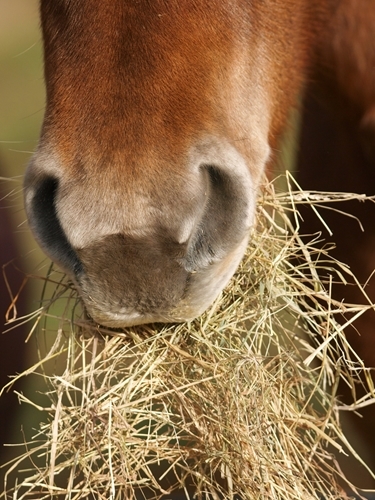Much of a horse’s health revolve around its digestion, yet in spite of the animal’s strength, their digestive systems are incredibly delicate. In essence, they are herbivores that can only process one type of plant material efficiently. Check out the essential information to know regarding the equine digestion process.
Teeth and lips: Same with all animals, digestion begins in the mouth. Horses have evolved to grasp and manipulate food using the lips before grinding feed into smaller pieces by the teeth. Generally it crops grass with the fore teeth and grinds it with the back teeth. The adult male horse typically has 40 permanent teeth and a mare has between 36 to 40 permanent teeth. Like humans, horses will have two sets of teeth in their lifetime. The baby teeth are temporary and by age five, most horses have their full set of permanent teeth.
As far as saliva goes, horses produce between 20-80 liters of saliva per day, facilitating the breakdown of food and swallowing process.
Stomach: Despite the animal’s size, horses have a small stomach. The average 1,000-pound horse only has a capacity of 2 to 4 gallons. Equine ulcers are believed to be triggered by their anatomy. Unlike humans’ stomachs, which are positioned vertically, horses’ stomachs are horizontal, so when they run, acid washes against the lining. Thus, performance horses may be at a higher risk for these ulcers.
No gallbladder: Another unique feature of horses is that they don’t have a gall bladder. In other animals, the gallbladder stores bile that helps digest fats. Because equines lack this organ, diets high in fat are difficult to digest. Though normal rations contain only 3 to 4 percent fat, larger rations with up to 20 percent fat may take horses up to four weeks to adjust to.
Small intestine: The horse’s small intestine is far from small. It is 50 to 70 feet long and can hold up to 23 gallons. The most digestion occurs in the small intestine, which is assisted by enzymes from the pancreas. The main nutrients – such as protein, a handful of carbohydrates and fat – as well as vitamins and minerals – vitamins A, D, E and K – are digested here.
Cecum: After the small intestine is the cecum. Most liquids are passed through the cecum, which measures 3 to 4 feet long and holds 7 to 8 gallons. Due to the bacteria and protozoa present, the cecum detoxifies toxic substances. The next section, the large intestine, begins with the cecum.
Large intestine: The digestive system ends with the large intestine. Stretching roughly 10 to 12 feet long, the large intestine has a capacity of about 16 gallons. This organ has four parts: the right ventral colon, sternal flexure to left ventral colon, pelvic flexure to left dorsal colon and diaphragmatic flexure to the right dorsal colon. Typically when colic occurs, it happens in the sternal and diaphragmatic flexure. The small colon leads to the rectum from where waste is deposited.
Maintaining pH levels for horse care
It’s crucial that the acidity in a horse’s digestive system remains balanced. According to Equinews, normal pH in separate regions of the equine digestive tract include: stomach (non-glandular), 5.4; stomach (glandular 2.6); small intestine, 7.4; cecum, 6.6; and small colon, 6.6.
It’s also helpful to know that the rate of digestion depends on feed type. For example, horses may take more than a half hour to eat 2 pounds of hay while the consumption of the same amount of concentrated feed could take as little as 10 minutes.








